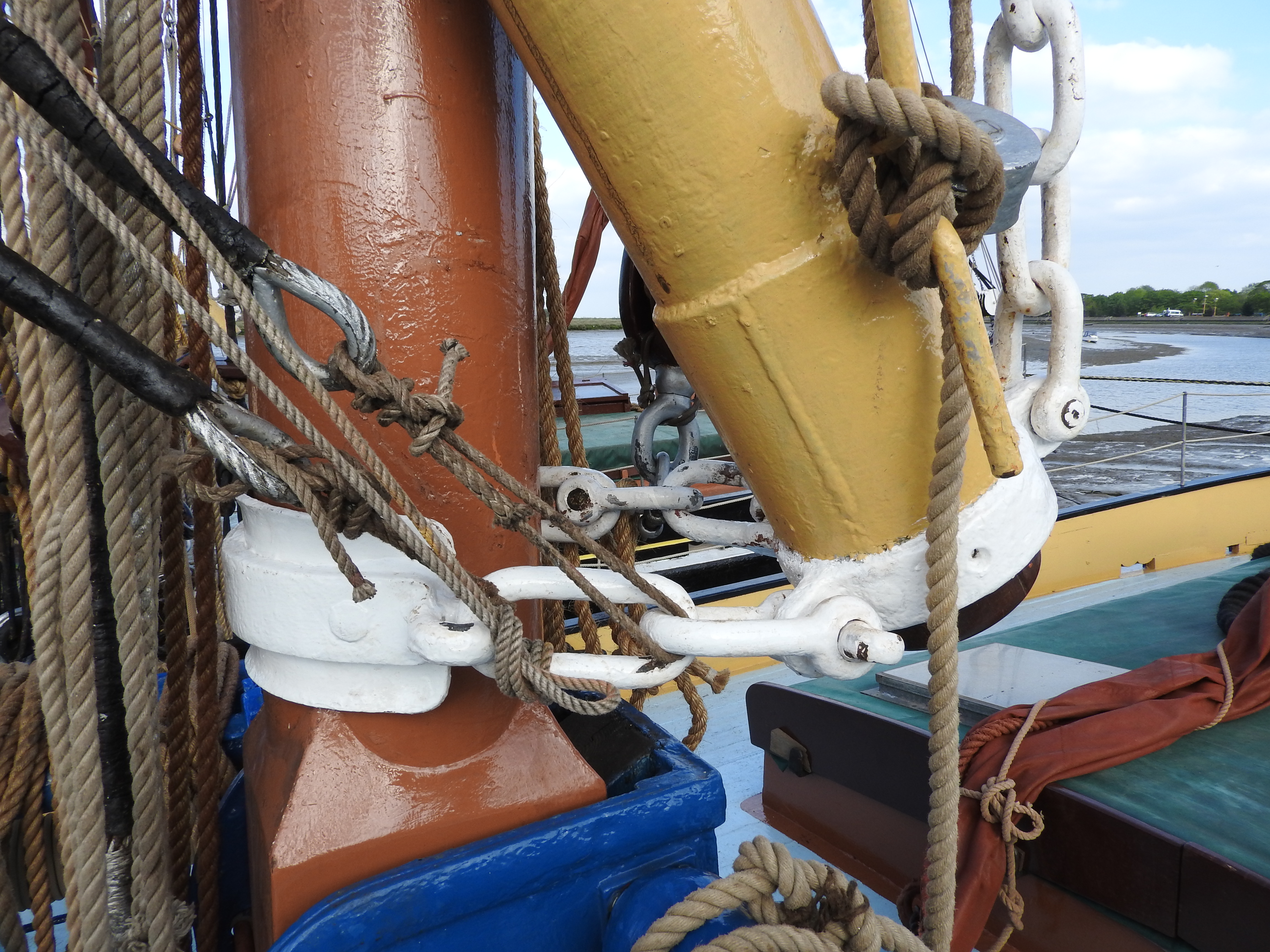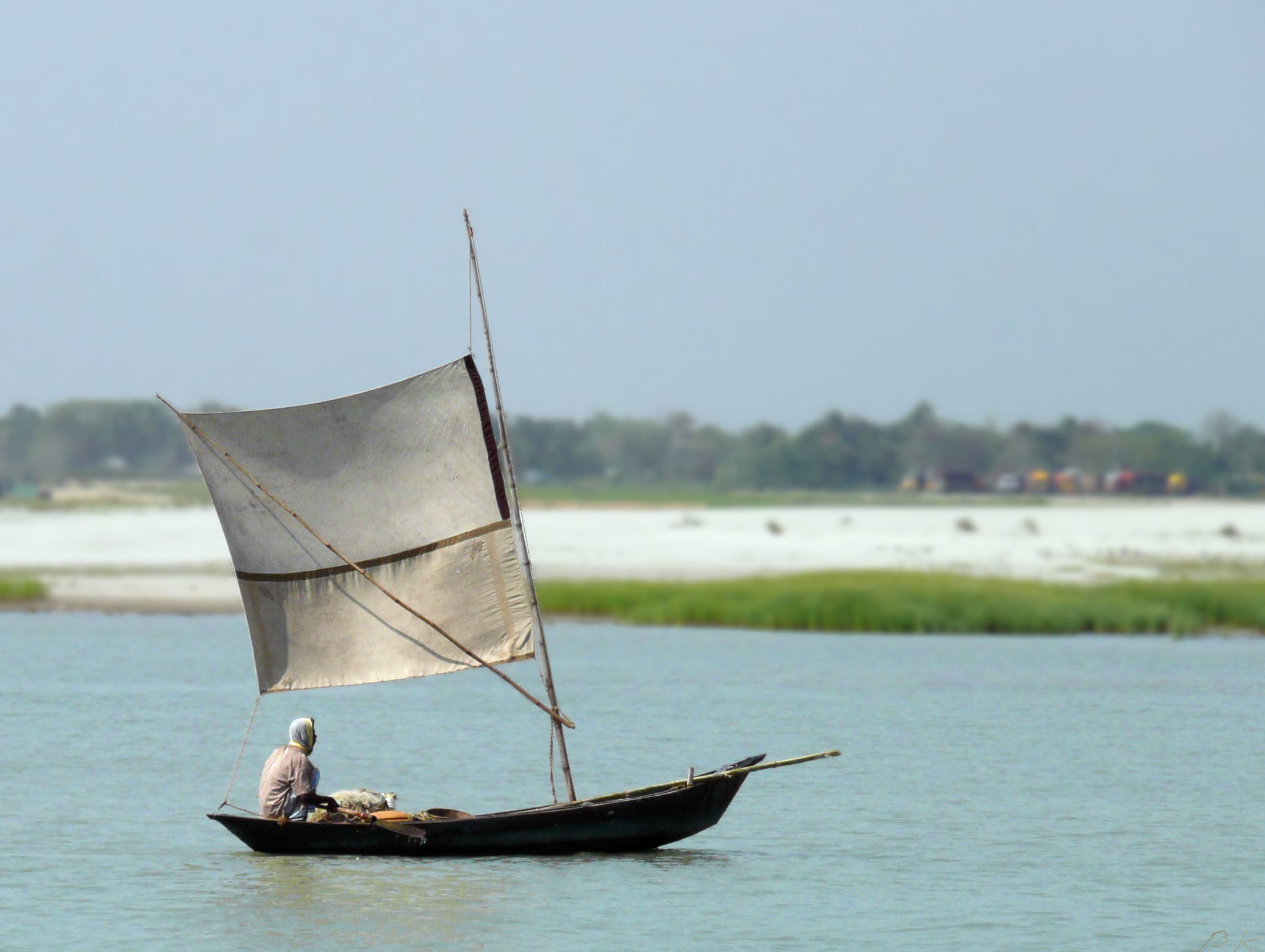Spritsail on:
[Wikipedia]
[Google]
[Amazon]
The spritsail is a four-sided, fore-and-aft sail that is supported at its highest points by the mast and a diagonally running spar known as the sprit. The foot of the sail can be stretched by a boom or held loose-footed just by its sheets. A spritsail has four corners: the

 The spritsail was best known from its use in the
The spritsail was best known from its use in the  This fine control of the sail without need for the crew to leave the deck, is achieved by ''brailing up''. Rather than lowering the
This fine control of the sail without need for the crew to leave the deck, is achieved by ''brailing up''. Rather than lowering the
 The spritsail is also commonly used in a fore-and-aft rig (along with a
The spritsail is also commonly used in a fore-and-aft rig (along with a Google Translate
/ref>
Web article
about triangular 'Leg-o-Mutton' sprit sail rig.
Video of sailing the Oselvar
A spritsail-rigged Norwegian traditional wooden boat. * {{Sail Types Sailing rigs and rigging
throat
In vertebrate anatomy, the throat is the front part of the neck, internally positioned in front of the vertebrae. It contains the Human pharynx, pharynx and larynx. An important section of it is the epiglottis, separating the esophagus from the t ...
, peak, clew
Sail components include the features that define a sail's shape and function, plus its constituent parts from which it is manufactured. A sail may be classified in a variety of ways, including by its orientation to the vessel (e.g. ''fore-and-a ...
, and tack. The
Spritsail can also be used to describe a rig that uses a spritsail.
Historically, spritsails were the first European fore-and-aft rigs, appearing in Greco-Roman navigation in the 2nd century BC.
The rig
The luff of the sail is bound to the mast, but unlike the gaff rig where thehead
A head is the part of an organism which usually includes the ears, brain, forehead, cheeks, chin, eyes, nose, and mouth, each of which aid in various sensory functions such as sight, hearing, smell, and taste. Some very simple ani ...
is bound to a spar, this rig supports the leech
Leeches are segmented parasitism, parasitic or Predation, predatory worms that comprise the Class (biology), subclass Hirudinea within the phylum Annelida. They are closely related to the Oligochaeta, oligochaetes, which include the earthwor ...
of the sail by means of a diagonal spar or spars named a sprit ( ). The forward end of the sprit spar is attached to the mast, with the after end of the sprit spar attached to the peak. The sprit is steadied and controlled from the deck by a pair of wire vangs ( ) attached to the peak of the sail. It is said to be the ancestor of the common gaff rig that evolved in 16th-century Holland
Holland is a geographical regionG. Geerts & H. Heestermans, 1981, ''Groot Woordenboek der Nederlandse Taal. Deel I'', Van Dale Lexicografie, Utrecht, p 1105 and former provinces of the Netherlands, province on the western coast of the Netherland ...
. The foot of the sail may be bent to a boom, or be loose-footed and just controlled by its sheets.
Barges

 The spritsail was best known from its use in the
The spritsail was best known from its use in the Thames sailing barge
A Thames sailing barge is a type of commercial sailing boat once common on the River Thames in London. The flat-bottomed barges, with a shallow draught and leeboards, were perfectly adapted to the Thames Estuary, with its shallow waters and na ...
, which employs two similarly sized spars to form the framework for the sail area. In a barge, the mast is stepped vertically in a mast case or tabernacle
According to the Hebrew Bible, the tabernacle (), also known as the Tent of the Congregation (, also Tent of Meeting), was the portable earthly dwelling of God used by the Israelites from the Exodus until the conquest of Canaan. Moses was instru ...
, whilst the sprit is suspended by chain stanliffs (standing lifts) from the hounds at the mast head at an angle of about 30° from vertical, with sprit to the starboard side of the mast. The heel of the sprit is secured to the mast, by the ''muzzle'', which allows the sprit the freedom to move laterally, nearly as far to each side as the shrouds. This enables the vessel to reach and run. The instability caused by allowing such a weighty spar to extend too far away from the vessel's centreline, however, had to be borne in mind when designing hull and rigging. The peak of the sail is permanently attached to the head of the sprit, which is steadied by two sets of vangs.
The spritsail rig was normally used without a boom. (The latter was usually found on fore-and-aft rigged vessels to keep the mainsail in an aerodynamically efficient shape.) Such loose-footed sails can also be found on gaff-rigged Norfolk wherries and the bawley class of vessel. The spritsail was a feature of the Cromster where the ability to furl the foot of the sail and raise the sheets, made gunnery much more readily possible. The sail could still be controlled using the vangs.
In a commercial vessel, the rig has the advantage of allowing a high stack of deck cargo and freeing the cargo hatch of obstructions when loading and unloading. The entire sail can be quickly brailed to the mast. The overriding advantage is safety in open water. Barges are unballasted and, if overpressed, will heel excessively and must be pulled to wind. The sheet will be eased and the aft end of a boom could drag in the water making the rudder ineffective and a capsize inevitable. The sheet of loose footed boomless barge is just released and control is regained. The boom does not project outboard so that the vessel can pass through a narrow gap between moored vessels. Loose footed sails suffer from sail twist which reduces their aerodynamic efficiency when sailing off the wind, which usually is not a commercial issue. It can be an advantage in light air. The vangs control the head of the sail which can be set so as to make use of the air above the wind-shadow of moored ships, warehouses and so on.
 This fine control of the sail without need for the crew to leave the deck, is achieved by ''brailing up''. Rather than lowering the
This fine control of the sail without need for the crew to leave the deck, is achieved by ''brailing up''. Rather than lowering the mainsail
A mainsail is a sail rigged on the main mast (sailing), mast of a sailing vessel.
* On a square rigged vessel, it is the lowest and largest sail on the main mast.
* On a fore-and-aft rigged vessel, it is the sail rigged aft of the main mast. T ...
, it is gathered up against its own luff and head by means of lines called ''brails''. This technique is an effective way of stowing the mainsail and gives fine control over the power obtained from the sail. In narrow channels, and in the lee of tall buildings the mailsail and mizzen are brailed and the bowsprit topped up, and she sails on topsail and foresail alone. A gaff rig was far more suitable for heavy weather and long sea passages, but when a gaff rigged vessel drops the mainsail, the topsail cannot be used. The gaff, attached to the mainsail, is required aloft to set the topsail.
However, the sprit rig means that the sail is stowed aloft and unreachable from the deck. It also means that the sail cannot easily be covered when it is stowed, and thus protected from the elements. But in any case, the crews of working vessels did not trouble with such dainty ways. In keeping with the general philosophy of working boats, all sails would therefore be traditionally treated with red oxide and other substances.
The problem of the inaccessibility of gear was met in the Thames barge by stepping the mast in a tabernacle and using a windlass on the foredeck to strike the whole lot, mast, sprit, sails and rigging. The crew could sail under a low bridge such as at Aylesford or Rochester without losing steerage way. The windlass is below the tack of the foresail and the tackle at the foot of the forestay. In striking the gear, the foresail tack tackle had to be cast off. With the bridge cleared, the skipper and an extra man (the huffler) used the windlass to raise the mast.
Dinghies
Modern use of the spritsail has also become more common through its use in the Optimist (dinghy) - this uses a boomed spritsail - in the case of which the sprit is tensioned by a snotter arrangement. This much simpler implementation sees the sprit anchored higher on the mast than on barges.Leg of mutton spritsail
This is a sprit rig that uses a triangular sail, the luff is bent to the mast, and the one spar, the sprit-boom attaches to the clew of the sail. The fore end of the boom is tensioned (pulled tight to the mast) by use of a snotter chord. It is a precursor of the wishbone rig first popularised by windsurfers. On a Bolger 59 (square foot) rig, there is a 14'3" luff, 13'7" leech and 9'0" foot.Local boats
 The spritsail is also commonly used in a fore-and-aft rig (along with a
The spritsail is also commonly used in a fore-and-aft rig (along with a staysail
A staysail ("stays'l") is a fore-and-aft rigged sail whose luff can be affixed to a stay running forward (and most often but not always downwards) from a mast to the deck, the bowsprit, or to another mast.
Description
Most staysails a ...
) on local traditional wooden boats of the west coast of Norway, most notably the faering variant of the Oselvar. Traditionally, up until the second half of the 1800s, these boats used to be rigged with a square rig
Square rig is a generic type of sail plan, sail and rigging arrangement in which a sailing ship, sailing vessel's primary driving sails are carried on horizontal spar (sailing), spars that are perpendicular (or wikt:square#Adjective, square) to t ...
./ref>
See also
* Crab claw sail * OselvarReferences
External links
Web article
about triangular 'Leg-o-Mutton' sprit sail rig.
Video of sailing the Oselvar
A spritsail-rigged Norwegian traditional wooden boat. * {{Sail Types Sailing rigs and rigging